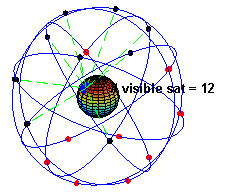Time to first fix
Time to first fix (TTFF) is a measure of the time required for a GPS navigation device to acquire satellite signals and navigation data, and calculate a position solution (called a fix).

An animation depicting the orbits of GPS satellites in medium earth orbit.
Scenarios
The TTFF is commonly broken down into three more specific scenarios, as defined in the GPS equipment guide:
- Cold or factory: The receiver is missing, or has inaccurate estimates of, its position, velocity, the time, or the visibility of any of the GPS satellites. As such, the receiver must systematically search for all possible satellites. After acquiring a satellite signal, the receiver can begin to obtain approximate information on all the other satellites, called the almanac. This almanac is transmitted repeatedly over 12.5 minutes. Almanac data can be received from any of the GPS satellites and is considered valid for up to 180 days. Manufacturers typically claim the factory TTFF to be 15 minutes.
- Warm or normal: The receiver has estimates of the current time within 20 seconds, the current position within 100 kilometers, and its velocity within 25 m/s, and it has valid almanac data. It must acquire each satellite signal and obtain that satellite's detailed orbital information, called ephemeris data. Each satellite broadcasts its ephemeris data every 30 seconds, and is valid for up to four hours.
- Hot or standby: The receiver has valid time, position, almanac, and ephemeris data, enabling a rapid acquisition of satellite signals. The time required of a receiver in this state to calculate a position fix may also be termed Time to Subsequent fix (TTSF)
Many receivers can use as many as twelve channels simultaneously, allowing quicker fixes.[1] Many cell phones reduce the time to first fix by using assisted GPS (A-GPS): they acquire almanac and ephemeris data over a fast network connection from the cell phone operator rather than over the slow radio connection from the satellites.
gollark: boop beep
gollark: PotatOS also has a viewsource command — view the code of your favourite potatostuff!
gollark: PotatOS has its ShutdownOS emulator function still.
gollark: PotatGoto: bad code backed by the power of potatOS.
gollark: With heavy use of the debug API goto may be practical.
See also
- Global Positioning System (GPS)
- GPS signals
- High Sensitivity GPS
References
- GPS information site Why twelve channels?
External links
- US Coast Guard, Navigation Center's NAVSTAR GPS User Equipment Introduction.
This article is issued from Wikipedia. The text is licensed under Creative Commons - Attribution - Sharealike. Additional terms may apply for the media files.